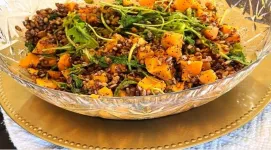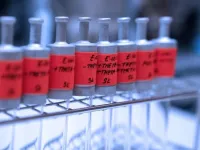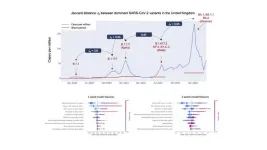Designing the ‘perfect’ meal to feed long-term space travelers
2024-01-02
(Press-News.org) Imagine blasting off on a multiyear voyage to Mars, fueled by a diet of bland, prepackaged meals. As space agencies plan for longer missions, they’re grappling with the challenge of how to best feed people. Now, researchers reporting in ACS Food Science & Technology have designed the optimal “space meal”: a tasty vegetarian salad. They chose fresh ingredients that meet male astronauts’ specialized nutritional needs and can be grown in space.
Astronauts in space burn more calories than humans on Earth and require extra micronutrients, such as calcium, to stay healthy during extended exposure to microgravity. Additionally, future long-term missions will require growing food in a sustainable, circular way within the spacecraft or space colonies. While researchers have explored methods of growing food in space and what nutrients astronauts require to stay healthy, specific fresh meals have not been developed. So, Volker Hessel and coworkers wanted to optimize a space meal that meets those unique requirements of spaceflight and tastes good.
First, the researchers assessed combinations of fresh ingredients, using a method called linear programming, which computationally balances different variables to meet a specific goal. In this case, their model identified how well the combinations of different foods could meet a male astronaut’s daily nutritional needs while minimizing the water required to grow the foods. The team was also concerned about the sustainability of the foods in space, selecting ingredients that needed little fertilizer, time and area to grow and whether inedible portions could be recycled. Of the 10 scenarios the researchers examined, they found that a vegetarian meal made up of soybeans, poppy seeds, barley, kale, peanuts, sweet potato and/or sunflower seeds provided the most efficient balance of maximal nutrients and minimal farming inputs. While this combination couldn’t quite provide all the micronutrients an astronaut needs, those missing could be added in a supplement, the researchers suggest.
To make sure that the identified combination was tasty, the team whipped up the ideal space meal as a salad for four people to taste test here on Earth. One tester gave rave reviews and “wouldn’t mind eating this all week as an astronaut.” Other people were more muted in their praise, even though they went back for second helpings. In the future, the researchers plan to see what their computer model dishes up as options for female astronauts and expand the variety of crops in their database.
The authors acknowledge funding from a University of Adelaide scholarship stipend.
###
The American Chemical Society (ACS) is a nonprofit organization chartered by the U.S. Congress. ACS’ mission is to advance the broader chemistry enterprise and its practitioners for the benefit of Earth and all its people. The Society is a global leader in promoting excellence in science education and providing access to chemistry-related information and research through its multiple research solutions, peer-reviewed journals, scientific conferences, eBooks and weekly news periodical Chemical & Engineering News. ACS journals are among the most cited, most trusted and most read within the scientific literature; however, ACS itself does not conduct chemical research. As a leader in scientific information solutions, its CAS division partners with global innovators to accelerate breakthroughs by curating, connecting and analyzing the world’s scientific knowledge. ACS’ main offices are in Washington, D.C., and Columbus, Ohio.
To automatically receive news releases from the American Chemical Society, contact newsroom@acs.org.
Note: ACS does not conduct research, but publishes and publicizes peer-reviewed scientific studies.
Follow us: Twitter | Facebook | LinkedIn | Instagram
END
[Attachments] See images for this press release:

ELSE PRESS RELEASES FROM THIS DATE:
2024-01-02
Perceived time has a significant impact on the actual time it takes to heal physical wounds, according to new research by Harvard psychologists Peter Aungle and Ellen Langer.
Their study, published late last month in Nature Scientific Reports, challenges conventional beliefs about psychological influences on physical health. The findings suggest a broader range of psychological influences than is currently appreciated.
To complete their study, the authors used a standardized procedure to mildly wound volunteer subjects. Perceived time was then manipulated in the lab, with each study participant completing three ...
2024-01-02
About The Study: This study of 67,000 freezing cycles among 47,000 patients reveals a distinct pattern in the utilization of cryopreserved oocytes among patients undergoing planned oocyte cryopreservation in the U.S. Despite the increase in number of patients pursuing oocyte cryopreservation, there is a notably low rate of return to utilize previously vitrified oocytes; notably, patients with poor ovarian response are more likely to return, although the time to return is similar to those with normal ovarian response.
Authors: Yuval Fouks, M.D., M.P.H., of Boston IVF-The Eugin Group in Waltham, Massachusetts, is the corresponding ...
2024-01-02
About The Study: The findings of this systematic review and meta-analysis of 23 randomized clinical trials including 3,100 parents suggest that problem-solving skills training for parents of children with chronic health conditions may improve the psychosocial well-being of the parents, their children, and their families. Further high-quality randomized clinical trials with longer follow-up times and that explore physical and clinical outcomes are encouraged to generate adequate evidence.
Authors: Yuanhui Luo, Ph.D., of Central South University in Changsha, Hunan, China, is the corresponding ...
2024-01-02
In a report just published in the journal Nature Climate Change, researchers argue that tackling inequality is vital in moving the world towards Net-Zero – because inequality constrains who can feasibly adopt low-carbon behaviours.
They say that changes are needed across society if we are to mitigate climate change effectively. Although wealthy people have very large carbon footprints, they often have the means to reduce their carbon footprint more easily than those on lower incomes.
The researchers say there is ...
2024-01-02
Synthetic biology offers the opportunity to build biochemical pathways for the capture and conversion of carbon dioxide (CO2). Researchers at the Max-Planck-Institute for Terrestrial Microbiology have developed a synthetic biochemical cycle that directly converts CO2 into the central building block Acetyl-CoA. The researchers were able to implement each of the three cycle modules in the bacterium E.coli, which represents a major step towards realizing synthetic CO2 fixing pathways within the context of living cells.
Developing new ways for the capture and conversion of CO2 is key to tackle ...
2024-01-02
Monitoring glucose levels is one of the key elements in health monitoring. A research team has now developed a battery-independent fluorescent nanosensor based on single-wall carbon nanotubes and an inactive form of the enzyme glucose oxidase (GOx). Because the enzyme is not in its active form, the analyte is not consumed during the measurement, and continuous, reversible, and non-invasive bioimaging of glucose levels in body fluids and tissues is possible, the team reports in the journal Angewandte Chemie.
Blood glucose levels are typically measured using GOx-based electrochemical sensors. However, these sensors ...
2024-01-02
After a long day, there’s the age-old question of do we eat out or stay in?
Over the last decade, that answer has increasingly shifted to eating out.
In that timeframe, households have increasingly spent more money on food outside of the home than what's spent on eating at home. In that same time, the farmer’s share of the food dollar eaten outside of the home has declined while the share of food eaten at home has increased.
With a more than $550,000 grant from the National Institute of Food and Agriculture, researchers George Davis and Anubhab Gupta, in the Department of Agricultural and Applied Economics in Virginia Tech's College ...
2024-01-02
New study finds that adolescent obesity significantly heightens the risk of developing early chronic kidney disease in young adulthood. Even those with high-normal BMI are at risk. Severe obesity poses the highest risk, but even mild obesity and being overweight contribute significantly to this increased risk for both males and females. Lowering obesity rates in adolescents is crucial to better managing the risk of kidney disease and subsequent cardiovascular issues. This study emphasizes the need for preventive measures and management of risk factors associated with chronic kidney disease ...
2024-01-02
Could healthy fats found in nuts and fish slow the progression of potentially deadly lung scarring known as pulmonary fibrosis and delay the need for lung transplants?
UVA pulmonary researchers looked at the association between blood-plasma levels of omega-3 fatty acids – the heart-healthy fats found in foods such as salmon and flaxseeds – and the progression of pulmonary fibrosis, as well as how long patients could go without needing a transplant. The researchers found that higher levels of omega-3 were associated with better lung function and longer transplant-free survival.
While more research ...
2024-01-02
An AI model can predict which SARS-CoV-2 variants are likely to cause new waves of infection. Current models used to predict the dynamics of viral transmission do not predict variant-specific spread. Retsef Levi and colleagues studied what factors could shape the viral spread based on analysis of 9 million SARS-CoV-2 genetic sequences collected by the Global Initiative on Sharing Avian Influenza Data (GISAID) from 30 countries, along with data on vaccination rates, infection rates, and other factors. The patterns that emerged from this analysis ...
LAST 30 PRESS RELEASES:
[Press-News.org] Designing the ‘perfect’ meal to feed long-term space travelers




